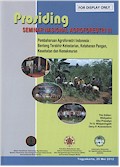| Paper |
 |
|
| Title | Analisis trade-off dan nilai ekonomi dari sistem penanaman campuran jati (Tectona Grandis) – jagung dalam berbagai pilihan praktek pengelolaan di Gunung Kidul | | Author | Ni'matul Khasanah, Aulia Perdana, Arif Rahmanullah, Gerhard Manurung, James M Roshetko and Meine van Noordwijk | | Editor | Widiyatno, Eko Prasetyo, Tri Sulistyati Widyaningsih and Devy Priambodo Kuswantoro | | Year | 2012 | | Parent Title | Prosiding Seminar Nasional Agroforestri III | | Pages | 54-63 | | Call Number | PP00399-12 |
|
| Abstract: |
| The district of Gunung Kidul has been experiencing fast growing expansion on smallholder teak plantations. At present, smallholder teak plantation is dominating the forest cover in the area with various planting management. WaNuLCAS model is used to explore growth and production of intercropping teak (Tectona grandis) – maize of smallholder teak under different management options in Gunung Kidul, West Java to identify the best possible management practice that would increase the economic value of smallholder teak. Initial spacing (1600 tree ha-1 (2.5 m x 2.5 m), 1111 tree ha-1 (3 m x 3 m) and 625 tree ha-1 (4 m x 4 m)), thinning (25%, 50% and 75% of tree density), and pruning (40% and 60% of crown biomass) are management practices explored in this study. The result show that the lowest cumulative maize yield at early stage of teak growth is provided by the system with narrow spacing (2.5 x 2.5 m) and cumulative maize yield is 10% – 37.5% higher when the tree spacing is widened to 3 x 3 m or 4 x 4 m. In this instance, where teak wood is the target of the systems, maize yield at the early stage of tree growth is clearly intercropping advantage either at low or high tree population density. This is shown by curve of plot of wood volume relative to monoculture versus crop yield relative to monoculture of all management practices explored is substantially above the straight trade-off curve. Optimum wood volume (m3 ha-1) is provided by the system with initial tree density 625 trees ha-1, 25% of it is thinned at year 5 and another 25% of it is thinned at year 15 and 40% of crown pruned at year 4, 10 and 15. However, greater stem diameter per tree is provided by 50% of thinning at year 5 results rather than 25% of thinning at year 5. Greater stem diameter is rewarded with higher market price. Currently, profitability analysis is applied to assess the trade-offs of the various managements and identify comparative practices. |
|